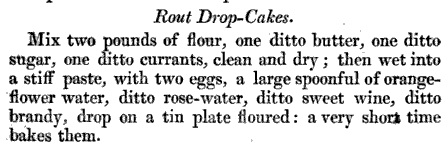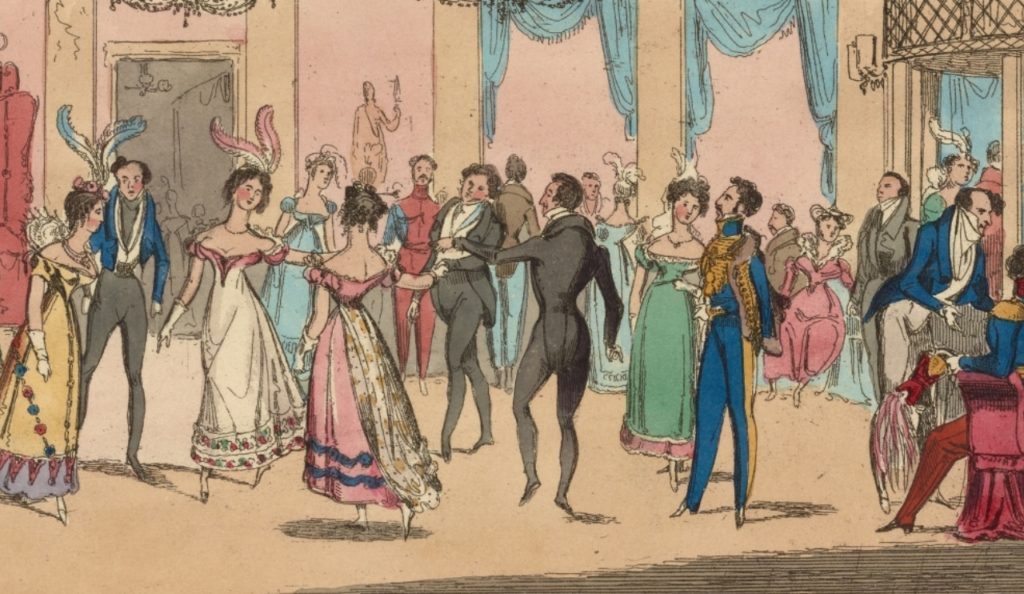Manners maketh man. William of Wykeham, Motto of Winchester College and New College, Oxford
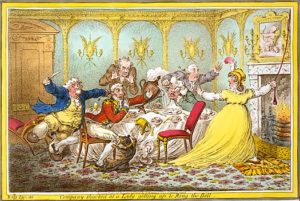
Company Shocked at a Lady Getting up to Ring the Bell, by James Gillray (1805)
By odd coincidence, both my actor son Graham and Elena’s daughter Gaile are in rehearsals for theater productions of Jane Austen works going up in March. Did someone declare March to be Jane Austen Theater month? Watching one of Graham’s rehearsals recently made me realize one of the greatest challenges these young actors face in trying to capture the historical flavor is bridging the gap between modern and period social graces.
I was asked to attend the rehearsal to share my so-called “expertise” with the cast members about titles, incomes, what constitutes a “gentleman” and who are and aren’t peers, etc. We had a good conversation about the characters in Pride & Prejudice, including things like why Darcy would be friends with Bingley, and why we should have more sympathy for Mrs. Bennett, comical as she is. But once the rehearsal began, I was vividly struck by how modern everyone was on stage, evidenced by the small matters of deportment, manners, and courtesy. I lump those together in the category of “social graces.” Does anyone learn those things anymore? 
For example, the cast members needed coaching in how to stand and how to move. The girls needed to learn not to sit with their legs apart or crossed at the knees, and not to stand with a hip thrust out while talking. The young men needed to learn not to slouch, whether sitting or standing, and not to sit down when the women around them were still standing! At the end of the rehearsal, to her credit, their young director made them all practice walking with good, straight posture and a consciousness of how they placed their feet and made their steps. A few of the behavioral “faux pas” I saw seem to have been written into the script –perhaps not the best adaptation of Austen’s P&P out there.

Philip Stanhope, 4th Earl of Chesterfield, by Wm. Hoare
In past centuries, aristocratic children were taught the rules of society and polite behavior from an early age. Knowing when to show emotion, how to dress and move elegantly, the rules for when and how to make proper calls, behave at a ball, conduct graceful conversation and act courteously proclaimed them as members of upper society. In his famous series of letters to his illegitimate son on how to behave and succeed in society, the 4th Earl of Chesterfield wrote: “I would heartily wish that you may often be seen to smile, but never heard to laugh while you live. Frequent and loud laughter is the characteristic of folly and ill-manners; it is the manner in which the mob express their silly joy at silly things; and they call it being merry.” (Full text of 400 letters: https://www.gutenberg.org/files/3361/3361-h/3361-h.htm Edited version of “best letters”: https://archive.org/details/bestlettersoflor00chesiala)
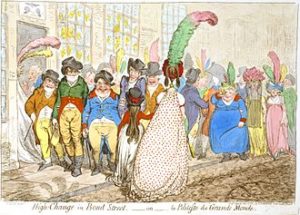
High Change in Bond Street, James Gillray (1796)
Failure to master these codes of conduct could mean failure to make a good marriage, failure to be successful in government service or failure in other opportunities both social and practical. Such failure betrayed a lack of “good breeding.” The young learned from parents, tutors and governesses, dance masters, and schools. Of course, that doesn’t mean when they were among their friends that they always toed the line. Most of us have heard of the highly rude behavior of young bucks loitering on Bond Street in Regency London.
In considering our Regency period, it makes sense to recognize that those who were then teaching had learned their social graces in the late 18th century, influenced by the ideas of the Enlightenment era. One examiner of those ideas was the 3rd Earl of Shaftsbury, who wrote a series of essays on the subject in the early 1700s. He wrote: “Politeness’ may be defined as a dext’rous management of our words and actions, whereby we make other people have better opinion of us and themselves.” Even across the pond, such worthies as Ben Franklin and George Washington wrote guidelines for proper deportment and courtesy. (Rules of Civility and Decent Behaviour In Company and Conversation by George Washington). A well-known but later resource was The Mirror of Graces (1811) by A Lady of Distinction.
Gaining entrée to this world of special social rules was the ambition of many middle class hopefuls as they gained in wealth but not status. This ambition helped to fuel the popularity of such periodicals as The Spectator, which regularly published advice on polite behavior. The unauthorized publication of the Earl of Chesterfield’s letters in 1774 was something of a scandal, not only for the breach of privacy, but also for exposing to the general public the information it contained. Samuel Johnson, who had a jaundiced view of Chesterfield anyway, claimed the letters “taught the morals of a courtesan and manners of a dancing master.” However, because they were never written for publication, they are all the more valuable for reflecting the reality of the social codes of the time, moral double standards and all.
As Regency writers, we have to be careful not to overlay our period with the increasingly restrictive codes that evolved during Victorian times and are better documented. One such resource was “The Ladies’ Book of Etiquette, and Manual of Politeness: A Complete Hand Book for the Use of the Lady in Polite Society” written by Florence Hartley, published in 1860.
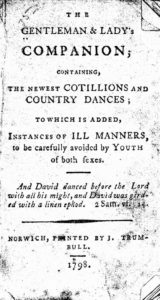 I am old enough that I was sent to “dancing school” as an after school activity, where we were indoctrinated with many of the same rules of behavior and courtesy more than a hundred years later. Did anyone else here suffer through doing that? I think it was during 6th and 7th grade. We generally hated it, but we not only learned how to waltz and cha-cha, we learned how to go through a receiving line, how to properly be asked to dance and how to respond, and a million other small tidbits of polite social behavior –much of which is outdated now, quite reasonably.
I am old enough that I was sent to “dancing school” as an after school activity, where we were indoctrinated with many of the same rules of behavior and courtesy more than a hundred years later. Did anyone else here suffer through doing that? I think it was during 6th and 7th grade. We generally hated it, but we not only learned how to waltz and cha-cha, we learned how to go through a receiving line, how to properly be asked to dance and how to respond, and a million other small tidbits of polite social behavior –much of which is outdated now, quite reasonably.
Yet I wonder, in becoming so relaxed, informal (and egalitarian) in our modern age, in tossing out many of the old rules of behavior, have we lost something that mattered? Or have we simply “leveled the playing field” socially by removing barriers and distinctions that in the past helped to separate classes (and enforce inequality between sexes)? I would love to know what you think!

